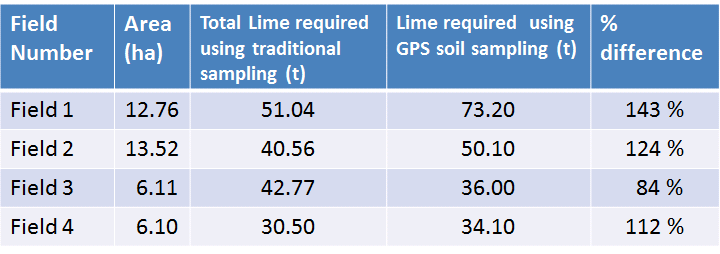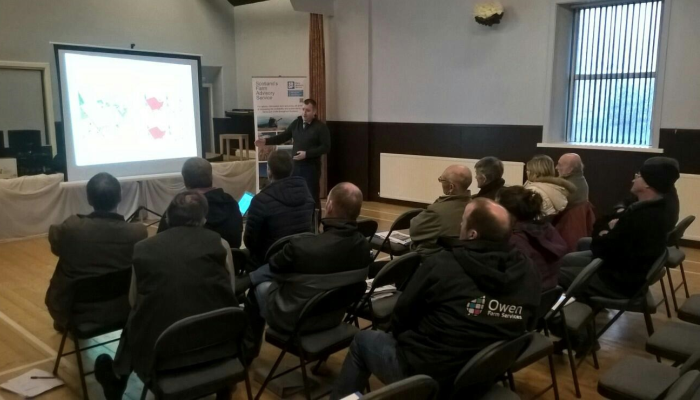Dumfriesshire Soil & Nutrient Network: Final meeting – event summary
5 December 2018GPS soil sampling and variable rate spreading were the focus of the final meeting of the Dumfriesshire Soil & Nutrient Network.
David Ross, SAC senior consultant, began the meeting talking about the basics of soil health and fertility and the importance of soil pH and P&K levels. He then talked about the different types of GPS soil sampling systems methods can be used to reduce in-field nutrient variation, reduce crop variability, increase yields and mazimise input efficiency.
We then looked at the 40ha which was GPS sampled at Limekilns, our host farm for this project. From the results available we were able to see the variation of pH, P & K across the fields. This led to a discussion on how to use these results to make decisions such as creating a nutrient budget, calculating lime requirements and the costs involved.
After the break David discussed the equipment required to carry out GPS soil sampling, how they work and the costs of implementing this type of technology. Historically we have soil sampled by walking the field in a ‘W’ pattern. For more detailed results farmers have several options available such as:
- Electromagnetic induction
- Hectare sampling – offering one sample per hectare (mixed from ~16 sub samples per ha)
- Grid sampling – offering four samples per hectare (mixed from up to a total of 48 samples per ha)
Using the results of soil sampling at Limekilns, David was able to demonstrate the financial value of employing GPS sampling by calculating the amount of lime required using both the traditional soil sampling results and then again using the GPS soil sample results. The calculations showed huge variations in lime requirements as shown in the table below.
When considering lime – remember the golden rules:
* 2 t/acre (5t/ha) maximum applied in one application
* If more required split the application
* Lime can take 18 months to fully neutralise
You can read all of David’s presentation slides here. Information available to take away from the event, and other relevant material can be downloaded using the links at the bottom of this page. Limekilns is one of twelve of the Soil & Nutrient host farms located across Scotland. Find out more about what the other host farms have discussed from our webpage.
Key Take Home Messages
1. Understand the soils you are farming
2. Understand the system you are using to test for nutrients either GPS or otherwise
3. Set your target pH based on current pH and cropping
4. Always correct pH first before applying P and K
5. Utilise farm manures to maintain P and K levels
6. Adopt GPS technology gradually, starting with lime and then P and K
- Valuing Your Soils – Practical Guidance for Scottish Farmers
- This brochure includes useful information about Scotland's agricultural soils and practical advice outlining the upfront financial savings and business benefits of better soil management and the efficient use of resources. Action and problem-specific 'field-sheets' are designed for busy farmers with limited time for reading.
- Topics: Climate Change, Soils, Water Management and Crops and Soils
- Technical Note (TN668): Managing Soil Phosphorus
- Efficient soil P management is challenging due to the varying ability of soils to mediate and regulate plant available forms of P. Farmers and land managers in Scotland are now able to access farm level information about their soils making it possible to provide more accurate P management advice.
- Topics: Crops and Soils
Sign up to the FAS newsletter
Receive updates on news, events and publications from Scotland’s Farm Advisory Service


